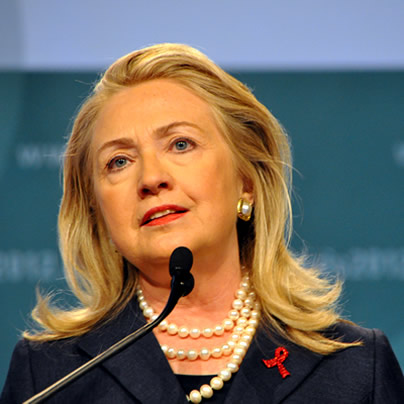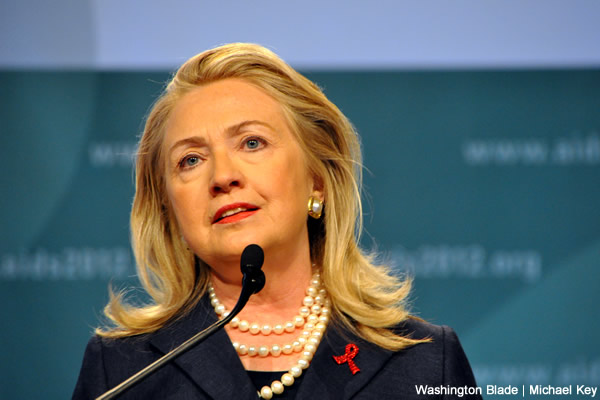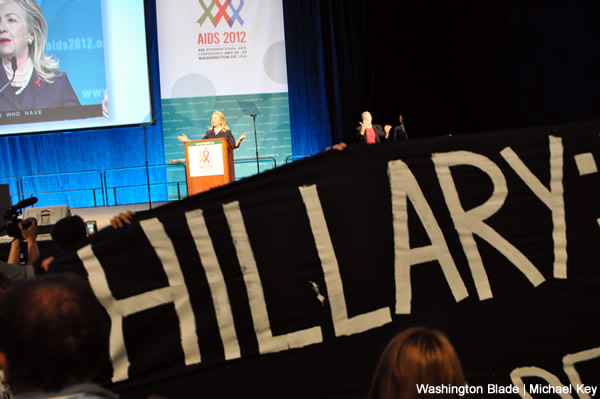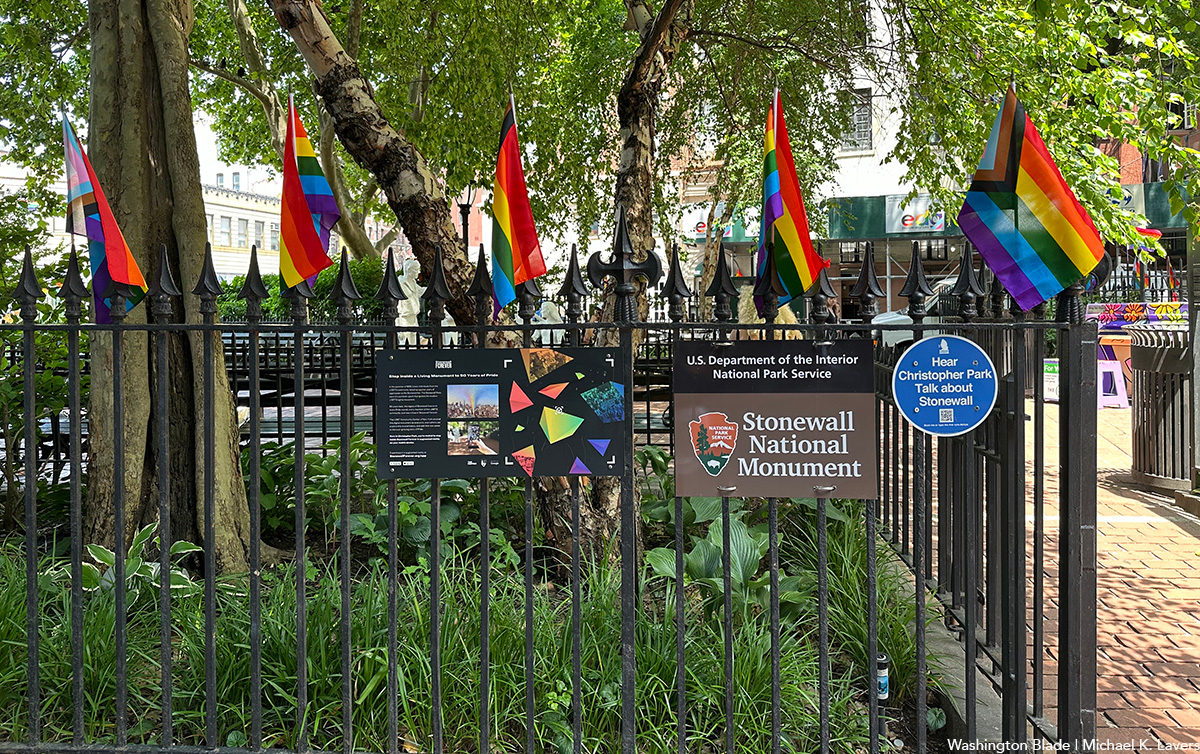National
AIDS 2012: Clinton announces ‘blueprint’ for ‘AIDS-free generation’
Identifies new funding streams to confront global epidemic


Secretary of State Hillary Clinton spoke Monday at the 19th International AIDS Conference (Blade photo by Michael Key)
Secretary of State Hillary Clinton announced on Monday that the United States would prepare a “blueprint” to confront the global AIDS epidemic and realize her previously stated vision of an “AIDS-free generation.”
In a speech before attendees in D.C. at the 19th International AIDS Conference, Clinton said she directed U.S. Global AIDS Coordinator Eric Goosby to develop the plan and said it would be unveiled before Dec. 1 on World AIDS Day.
“I have asked Ambassador Dr. Goosby to take the lead on developing and sharing our blueprint of the goals and objectives for the next phase of our effort and to release this blueprint by World AIDS Day this year,” Clinton said. “We want the next Congress, the next secretary of state, and all of our partners here at home and around the world to have a clear picture of everything we’ve learned and a roadmap that shows what we will contribute to achieving an AIDS-free generation.”
Clinton first articulated the idea of an “AIDS-free generation” during remarks she delivered on World AIDS Day last year.
A number of HIV/AIDS advocates praised the idea of a blueprint in the global fight against HIV/AIDS as they called for the strategy to include certain enumerated provisions.
Chris Collins, vice president of policy for amFAR, said he’s hoping the plan would articulate the way forward in confronting the global AIDS epidemic, which has claimed the lives of more than 25 million across the globe.
“When you want to accomplish a complex goal you need a clear plan of action,” Collins said. “Creation of a blueprint is an important step forward because it directs our planning, policy and funding toward achieving clear outcomes and goals and will help everyone engaged monitor progress toward an AIDS-free generation.”
In a joint statement, 65 advocacy and implementation organizations said the blueprint needs to contain several key points to succeed, such as defining specific outcome targets for HIV incidence, morbidity and mortality; requiring full transparency of U.S. government budgets; and requiring detailed annual reporting on progress.
During the same speech, Clinton unveiled five new funding streams aiming to target populations that are particularly affected by HIV/AIDS overseas, touting a “combination prevention” strategy of treatment and prevention.
The five new funding streams total $157 million:
• an additional $80 million to support approaches that ensure HIV-positive pregnant women receive treatment to protect themselves and prevent them from spreading the disease to their children and partners;
• an additional $40 million to support South Africa’s plans to provide voluntary medical male circumcisions for almost half a million boys and men in the next year;
• $15 million for implementation research to identify the specific interventions that are most effective for reaching key populations;
• $20 million to launch a challenge fund to support country-led plans to expand services for key populations; and
• a $2 million investment in the Robert Carr Civil Society Networks Fund to bolster the efforts of civil society groups in addressing key populations.
Clinton said keeping women in Africa with HIV healthy is important to keep them from transferring the disease to their unborn children, which she said the United States is committed to ending by 2015.
A number of female HIV/AIDS advocates at the conference called for greater attention to the disease’s impact on children. In sub-Saharan Africa, which has been particularly affected by AIDS, an estimated 60 percent of those living with HIV are women.
“When women are identified as HIV-positive and eligible for treatment, they are often referred to another clinic, one that may be too far away for them to reach,” Clinton said. “As a result, too many women never start treatment. Today, I am announcing that the United States will invest an additional $80 million to fill this gap. These funds will support innovative approaches to ensure that HIV-positive pregnant women get the treatment they need to protect themselves, their babies and their workers.”
Clinton’s speech was highly anticipated among the estimated 25,000 people in attendance at the conference. Organizers sent attendees to overflow rooms a full half-hour before she came on stage because the large room in which she was set to speak was already filled to capacity.
Upon her arrival, Clinton was greeted with a standing ovation from attendees. But not everyone received her favorably.
A group of protesters could be heard shouting at the secretary as she approached the podium. They held up a sign calling on Clinton to take “Trans Pacific” action against AIDS — apparently out of concern of insufficient funds for trans people affected by AIDS overseas. Clinton responded, “What would an AIDS conference be without a little protesting? We understand that.”
Some HIV/AIDS advocates have criticized the Obama administration for not doing enough to fight the global epidemic. The president’s budget request for fiscal year 2013 cuts half a billion dollars from the President’s Emergency Plan for AIDS Relief, a program established by President George W. Bush to confront the global epidemic, as the White House maintained the program is doing more with less because of the reduced cost of drugs.

Protesters shout at Clinton during remarks at AIDS conference (Blade photo by Michael Key)
Despite this proposed cut, Clinton emphasized new accomplishments for PEPFAR under the Obama administration, saying the program is funding 600,000 more people since December. She said this increase means PEPFAR is reaching nearly 4.5 million people and is on track to meet the administration’s goal of treating 6 million people by the end of 2013, which President Obama announced on World AIDS Day last year.
“Now since that time I’ve heard a few voices from people raising questions about America’s commitment to an AIDS-free generation, wondering whether we are really serious about achieving it,” Clinton said. “Well, I am here today to make it absolutely clear: the United States is committed and will remain committed to achieving an AIDS-free generation. We will not back off, we will not back down, we will fight for the resources necessary to achieve this historic milestone.”
Additionally, Clinton said PEPFAR is reaching more than 370,000 women globally and has supported more than 400,000 male circumcisions, which has been shown to reduce HIV transmission, since December.
“You know and we want the world to know that this procedure reduces the risk of female-to-male transmission by more than 60 percent and for the rest of the man’s life, so the impact can be phenomenal,” Clinton said. “In Kenya and Tanzania, mothers asked for circumcision campaigns during school vacations so their teenage sons could participate. In Zimbabwe, some male lawmakers want to show their constituents how safe and virtually painless the procedure is, so they went to a mobile clinic and got circumcised. That’s the kind of leadership we welcome.”
But as she emphasized U.S. efforts in confronting the epidemic, Clinton also called for partner nations to step up their game to confront the disease in their own countries, saying reaching the goal “is a shared responsibility.”
“I spoke earlier about how the United States is supporting country ownership, but we also look to our partner countries and donors to do their part,” Clinton said. “They can follow the example of the last few years in South Africa, Namibia, Botswana, India and other countries who are able to provide more and better care for their own people because they are committing more of their own resources to HIV/AIDS. And partner countries also need to take steps like fighting corruption and making sure their systems for approving drugs are as efficient as possible.”
As part of this commitment, Clinton called on other countries to contribute to the Global Fund to Fight AIDS, Tuberculous and Malaria. Obama’s most recent budget request affirms the administration’s commitment to provide $4 billion over three years to the fund, and Clinton said Saudi Arabia, Japan, Germany, the Gates Foundation and others have stepped up their efforts.
Paul Zeitz, vice president of policy for the D.C.-based ACT V: The End of AIDS, joined in the call for other countries to step up their efforts in confronting HIV/AIDS as he commended Clinton for announcing her plan to produce a blueprint in the global fight.
“As we all know, money is the oxygen for action for creating an AIDS-Free Generation,” Zeitz said. “Action speaks louder and we need to make sure that governments around the world step up to pay their fare share, including my own government. U.S. leadership in the global battle to end AIDS is an essential catalyst.”
Federal Government
UPenn erases Lia Thomas’s records as part of settlement with White House
University agreed to ban trans women from women’s sports teams

In a settlement with the Trump-Vance administration announced on Tuesday, the University of Pennsylvania will ban transgender athletes from competing and erase swimming records set by transgender former student Lia Thomas.
The U.S. Department of Education’s Office for Civil Rights found the university in violation of Title IX, the federal rights law barring sex based discrimination in educational institutions, by “permitting males to compete in women’s intercollegiate athletics and to occupy women-only intimate facilities.”
The statement issued by University of Pennsylvania President J. Larry Jameson highlighted how the law’s interpretation was changed substantially under President Donald Trump’s second term.
“The Department of Education OCR investigated the participation of one transgender athlete on the women’s swimming team three years ago, during the 2021-2022 swim season,” he wrote. “At that time, Penn was in compliance with NCAA eligibility rules and Title IX as then interpreted.”
Jameson continued, “Penn has always followed — and continues to follow — Title IX and the applicable policy of the NCAA regarding transgender athletes. NCAA eligibility rules changed in February 2025 with Executive Orders 14168 and 14201 and Penn will continue to adhere to these new rules.”
Writing that “we acknowledge that some student-athletes were disadvantaged by these rules” in place while Thomas was allowed to compete, the university president added, “We recognize this and will apologize to those who experienced a competitive disadvantage or experienced anxiety because of the policies in effect at the time.”
“Today’s resolution agreement with UPenn is yet another example of the Trump effect in action,” Education Secretary Linda McMahon said in a statement. “Thanks to the leadership of President Trump, UPenn has agreed both to apologize for its past Title IX violations and to ensure that women’s sports are protected at the university for future generations of female athletes.”
Under former President Joe Biden, the department’s Office of Civil Rights sought to protect against anti-LGBTQ discrimination in education, bringing investigations and enforcement actions in cases where school officials might, for example, require trans students to use restrooms and facilities consistent with their birth sex or fail to respond to peer harassment over their gender identity.
Much of the legal reasoning behind the Biden-Harris administration’s positions extended from the 2020 U.S. Supreme Court case Bostock v. Clayton County, which found that sex-based discrimination includes that which is based on sexual orientation or gender identity under Title VII rules covering employment practices.
The Trump-Vance administration last week put the state of California on notice that its trans athlete policies were, or once were, in violation of Title IX, which comes amid the ongoing battle with Maine over the same issue.
New York
Two teens shot steps from Stonewall Inn after NYC Pride parade
One of the victims remains in critical condition

On Sunday night, following the annual NYC Pride March, two girls were shot in Sheridan Square, feet away from the historic Stonewall Inn.
According to an NYPD report, the two girls, aged 16 and 17, were shot around 10:15 p.m. as Pride festivities began to wind down. The 16-year-old was struck in the head and, according to police sources, is said to be in critical condition, while the 17-year-old was said to be in stable condition.
The Washington Blade confirmed with the NYPD the details from the police reports and learned no arrests had been made as of noon Monday.
The shooting took place in the Greenwich Village neighborhood of Manhattan, mere feet away from the most famous gay bar in the city — if not the world — the Stonewall Inn. Earlier that day, hundreds of thousands of people marched down Christopher Street to celebrate 55 years of LGBTQ people standing up for their rights.
In June 1969, after police raided the Stonewall Inn, members of the LGBTQ community pushed back, sparking what became known as the Stonewall riots. Over the course of two days, LGBTQ New Yorkers protested the discriminatory policing of queer spaces across the city and mobilized to speak out — and throw bottles if need be — at officers attempting to suppress their existence.
The following year, LGBTQ people returned to the Stonewall Inn and marched through the same streets where queer New Yorkers had been arrested, marking the first “Gay Pride March” in history and declaring that LGBTQ people were not going anywhere.
New York State Assemblywoman Deborah Glick, whose district includes Greenwich Village, took to social media to comment on the shooting.
“After decades of peaceful Pride celebrations — this year gun fire and two people shot near the Stonewall Inn is a reminder that gun violence is everywhere,” the lesbian lawmaker said on X. “Guns are a problem despite the NRA BS.”
New York
Zohran Mamdani participates in NYC Pride parade
Mayoral candidate has detailed LGBTQ rights platform

Zohran Mamdani, the candidate for mayor of New York City who pulled a surprise victory in the primary contest last week, walked in the city’s Pride parade on Sunday.
The Democratic Socialist and New York State Assembly member published photos on social media with New York Attorney General Letitia James, telling followers it was “a joy to march in NYC Pride with the people’s champ” and to “see so many friends on this gorgeous day.”
“Happy Pride NYC,” he wrote, adding a rainbow emoji.
Mamdani’s platform includes a detailed plan for LGBTQ people who “across the United States are facing an increasingly hostile political environment.”
His campaign website explains: “New York City must be a refuge for LGBTQIA+ people, but private institutions in our own city have already started capitulating to Trump’s assault on trans rights.
“Meanwhile, the cost of living crisis confronting working class people across the city hits the LGBTQIA+ community particularly hard, with higher rates of unemployment and homelessness than the rest of the city.”
“The Mamdani administration will protect LGBTQIA+ New Yorkers by expanding and protecting gender-affirming care citywide, making NYC an LGBTQIA+ sanctuary city, and creating the Office of LGBTQIA+ Affairs.”
-

 U.S. Supreme Court4 days ago
U.S. Supreme Court4 days agoSupreme Court upholds ACA rule that makes PrEP, other preventative care free
-

 U.S. Supreme Court4 days ago
U.S. Supreme Court4 days agoSupreme Court rules parents must have option to opt children out of LGBTQ-specific lessons
-

 Television5 days ago
Television5 days ago‘White Lotus,’ ‘Severance,’ ‘Andor’ lead Dorian TV Awards noms
-

 Music & Concerts5 days ago
Music & Concerts5 days agoBerkshire Choral to commemorate Matthew Shepard’s life











